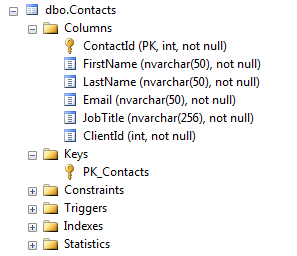When I was building out this demo I started to use VS 2012 with .NET 4.5. However when the GridView rendered, I could not figure out how to change the widths of the columns. The grid was really ugly looking. After spending too much time, I fell back to using VS 2010 with .NET 4.0. If anyone knows how to deal with this, please email csharpavacado@gmail.com so I can update this.
Here is a screenshot of the database tables, Account and Contacts:
I just spun up a new WebForms project and ripped out the initial Default.aspx code. Here is the code for the GridView in Default.aspx:
<%@ Page Title="Home Page"e; Language="C#" MasterPageFile=" ~/Site.Master" AutoEventWireUp="true" CodeBehind="Default.aspx.cs" Inherits="GVDemo2010._Defautlt" %>
<asp:Content ID="HeaderContent" runat="server"
ContentPlaceHolderID="HeadContent">
</asp:Content>
<asp:ContentID="BodyContent" runat="server"
ContentPlaceHolderID="MainContent">
<asp:GridView runat="server" AutoGenerateColumns="False" OnRowCancelingEdit="gvAccount_RowCancelingEdit" OnRowDataBound="gvAccount_RowDataBound"OnRowEditing="gvAccount_RowEditing"OnRowUpdating="gvAccount_RowUpdating"OnRowCommand="gvAccount_RowCommand"ShowFooter="True"EnableViewState="False"Width="900px">
<Columns>
<asp:TemplateField HeaderText="Account Name" HeaderStyle-HorizontalAlign="Left">
<EditItemTemplate>
<asp:Label runat="server"ID="lblAccountName"Text='<%# Bind("AccountName") %>'></asp:Label>
</EditItemTemplate>
<ItemTemplate>
<asp:Label runat="server"ID="lblAccountName"Text='<%# Bind("AccountName") %>'></asp:Label>
</ItemTemplate>
</asp:TemplateField>
<asp:TemplateField HeaderText="Primary First" HeaderStyle-HorizontalAlign="Left">
<ItemTemplate>
<asp:HiddenField runat="server" ID="primaryContactId" Value='<%# Bind("PrimaryContactId") %>'/>
</ItemTemplate>
<EditItemTemplate>
<asp:TextBox runat="server" ID="txtPrimaryContactFirst" Text='<%# Bind("PrimaryContactFirstName") %>'></asp:TextBox>
</EditItemTemplate>
<FooterTemplate>
<asp:TextBox runat="server" ID="txtNewPrimaryContactFirst"></asp:TextBox>
</FooterTemplate>
<ItemTemplate>
<asp:Label runat="server" ID="lblPrimaryContactFirst" Text='<%# Bind("PrimaryContactFirstName") %>'></asp:Label>
</ItemTemplate>
</asp:TemplateField>
<asp:TemplateField HeaderText="Primary Last" HeaderStyle-HorizontalAlign="Left">
<EditItemTemplate>
<asp:TextBox runat="server" ID="txtPrimaryContactLast" Text='<%# Bind("PrimaryContactLastName") %>'></asp:TextBox>
</EditItemTemplate>
<FooterTemplate>
<asp:TextBox runat="server" ID="txtNewPrimaryContactLast"></asp:TextBox>
</FooterTemplate>
<ItemTemplate>
<asp:Label runat="server" ID="lblPrimaryContactLast" Text='<%# Bind("PrimaryContactLastName") %>'></asp:Label>
</asp:TemplateField>
<asp:TemplateField HeaderText="Secondary First" HeaderStyle-HorizontalAlign="Left">
<ItemTemplate>
<asp:HiddenField runat="server" ID="secondaryContactId" Value='<%# Bind("SecondaryContactId") %>'/>
</ItemTemplate>
<EditItemTemplate>
<asp:TextBox runat="server" ID="txtSecondaryContactFirst" Text='<%# Bind("SecondaryContactFirstName") %>'></asp:TextBox>
</EditItemTemplate>
<FooterTemplate>
<asp:TextBox runat="server" ID="txtNewSecondaryContactFirst"></asp:TextBox>
</FooterTemplate>
<ItemTemplate>
<asp:Label runat="server" ID="lblSecondaryContactFirst" Text='<%# Bind("SecondaryContactFirstName") %>'></asp:Label>
</ItemTemplate>
<asp:TemplateField HeaderText="Secondary Last" HeaderStyle-HorizontalAlign="Left">
<EditItemTemplate>
<asp:TextBox runat="server" ID="txtSecondaryContactLast" Text='<%# Bind("SecondaryContactLastName") %>'></asp:TextBox<
</EditItemTemplate>
<FooterTemplate>
<asp:TextBox runat="server" ID="txtNewSecondaryContactLast"></asp:TextBox>
</FooterTemplate>
<ItemTemplate>
<asp:Label runat="server" ID="lblSecondaryContactLast" Text='<%# Bind("SecondaryContactLastName") %>'></asp:Label>
</ItemTemplate>
</asp:TemplateField>
<asp:TemplateField HeaderText="Deleted" HeaderStyle-HorizontalAlign="Left">
<EditItemTemplate>
<asp:TextBox runat="server" ID="txtDeleted" Text='<%# Bind("Deleted") %>'></asp:TextBox&<
</EditItemTemplate>
<FooterTemplate>
<asp:TextBox runat="server" ID="txtNewDeleted"></asp:TextBox>
</FooterTemplate>
<ItemTemplate>
<asp:Label runat="server" ID="lblDeleted" Text='<%# Bind("Deleted") %>'></asp:Label>
</ItemTemplate>
</asp:TemplateField>
<asp:TemplateField HeaderText="Edit" HeaderStyle-HorizontalAlign="Left">
<EditItemTemplate>
<asp:LinkButton runat="server" ID="lnkUpdate" CausesValidation="True" CommandName="Update" Text="Update"></asp:LinkButton>
<asp:LinkButton runat="server" ID="lnkCancel" CausesValidation="False" CommandName="Cancel" Text="Cancel"></asp:LinkButton
</EditItemTemplate>
<FooterTemplate>
<asp:LinkButton runat="server" ID="lnkAdd" CausesValidation="False" CommandName="Insert" Text="Insert"></asp:LinkButton>
</FooterTemplate>
<ItemTemplate>
<asp:LinkButton runat="server" ID="lnkEdit" CausesValidation="False" CommandName="Edit" Text="Edit"></asp:LinkButton>
</ItemTemplate>
</asp:TemplateField>
</Columns>
</asp:GridView>
</asp:Content>
The markup in the aspx file contains markup for in-line editing. I'm not going to go all the way on that, but we will do an edit. Now the code behind, Default.aspx.cs:
public partial class _Default : System.Web.UI.Page
{
protected void Page_Load(object sender, EventArgs e)
{
FillGrid();
}
private void FillGrid()
{
// 1 is client Id, hardcode for demo purpose
// db layout will be shown later
DataTable dt = GetAccountDataTable(1);
gvAccount.DataSource = dt;
gvAccount.DataBind();
}
protected void gvAccount_RowDataBound(object sender, GridViewRowEventArgs e)
{
}
protected void gvAccount_RowCancelingEdit(object sender, GridViewCancelEditEventArgs e)
{
gvAccount.EditIndex = -1;
FillGrid();
}
protected void gvAccount_RowCommand(object sender, GridViewCommandEventArgs e)
{
}
protected void gvAccount_RowEditing(object sender, GridViewEditEventArgs e)
{
gvAccount.EditIndex = e.NewEditIndex;
FillGrid();
}
protected void gvAccount_RowUpdating(object sender, GridViewUpdateEventArgs e)
{
int index = e.RowIndex;
DataTable dt = (DataTable) gvAccount.DataSource;
int accountId = (int) dt.Rows[index].ItemArray.GetValue(0);
int primaryContactId = (int) dt.Rows[index].ItemArray.GetValue(2);
int secondaryContactId = (int) dt.Rows[index].ItemArray.GetValue(5);
TextBox primaryContactFirst =
(TextBox) gvAccount.Rows[e.RowIndex].FindControl("txtPrimaryContactFirst");
TextBox primaryContactLast =
(TextBox) gvAccount.Rows[e.RowIndex].FindControl("txtPrimaryContactLast");
TextBox secondaryContactFirst =
(TextBox) gvAccount.Rows[e.RowIndex].FindControl("txtSecondaryContactFirst");
TextBox secondaryContactLast =
(TextBox) gvAccount.Rows[e.RowIndex].FindControl("txtSecondaryContactLast");
TextBox deleted = (TextBox) gvAccount.Rows[e.RowIndex].FindControl("txtDeleted");
UpdateRecord(accountId, primaryContactId, primaryContactFirst.Text, primaryContactLast.Text,
secondaryContactId, secondaryContactFirst.Text, secondaryContactLast.Text, deleted.Text)
gvAccount.EditIndex = -1;
FillGrid();
}
private static DataTable GetAccountDataTable(int clientId)
{
DataTable dt = new DataTable();
dt.Columns.Add(new DataColumn("AccountId", typeof(Int32)));
dt.Columns.Add(new DataColumn("AccountName", typeof(String)));
dt.Columns.Add(new DataColumn("PrimaryContactId", typeof(Int32)));
dt.Columns.Add(new DataColumn("PrimaryContactFirstName", typeof(String)));
dt.Columns.Add(new DataColumn("PrimaryContactLastName", typeof(String)));
dt.Columns.Add(new DataColumn("SecondaryContactId", typeof(Int32)));
dt.Columns.Add(new DataColumn("SecondaryContactFirstName", typeof(String)));
dt.Columns.Add(new DataColumn("SecondaryContactLastName", typeof(String)));
dt.Columns.Add(new DataColumn("Deleted", typeof(Boolean)));
string connectionString =
ConfigurationManager.ConnectionStrings["YourDbName"].ConnectionString;
SqlConnection sqlConnection = new SqlConnection(connectionString);
SqlCommand sqlCommand =
new SqlCommand("GetContactsByClientId", sqlConnection) { CommandType = CommandType.StoredProcedure };
sqlCommand.Parameters.Add(new SqlParameter("@ClientId", clientId));
SqlDataAdapter adapter = new SqlDataAdapter { SelectCommand = sqlCommand };
adapter.Fill(dt);
return dt;
}
private static void UpdateRecord(int accountId, int primaryContactId, string primaryFirst,
string primaryLast, int secondaryContactId, string secondaryFirst,
string secondaryLast, string deleted)
{
string connectionString =
ConfigurationManager.ConnectionStrings["YourDbName"].ConnectionString;
SqlConnection sqlConnection = new SqlConnection(connectionString);
SqlParameter[] parameters = new SqlParameter[8];
parameters[0] = new SqlParameter("@AccountId", SqlDbType.Int, 0) { Value = accountId };
parameters[1] = new SqlParameter("@PrimaryContactId", SqlDbType.Int, 0) { Value = primaryContactId };
parameters[2] = new SqlParameter("@PrimaryContactFirst", SqlDbType.NVarChar, 50) {Value = primaryFirst};
parameters[3] = new SqlParameter("@PrimaryContactLast", SqlDbType.NVarChar, 50) {Value = primaryLast};
parameters[4] = new SqlParameter("@SecondaryContactId", SqlDbType.Int, 0) {Value = SecondaryContactId};
parameters[5] = new SqlParameter("@SecondaryContactFirst", SqlDbType.NVarChar, 50) {Value = secondaryFirst};
parameters[6] = new SqlParameter("@SecondaryContactLast", SqlDbType.NVarChar, 50) {Value = secondaryLast};
parameters[7] = new SqlParameter("@Deleted", SqlDbType.Bit, 0) {Value = Convert.ToBoolean(deleted)};
SqlCommand sqlCommand =
new SqlCommand ("UpdateContactInfo", sqlConnection) {CommandType = CommandType.StoredProcedure};
sqlCommand.Parameters.AddRange(parameters);
sqlConnection.Open();
sqlCommand.ExecuteNonQuery();
sqlConnection.Close();
}
}
We have two stored procedures to write, first, dbo.GetContactsByClientId:
USE [YourDbName]
GO
SET ANSI_NULLS ON
GO
SET QUOTED_IDENTIFIER ON
GO
CREATE PROCEDURE [dbo].[GetContactsByClientId]
@ClientId INT
AS
BEGIN
SELECT account.AccountId, account.AccountName,
c1.ContactId AS "PrimaryContactId', c1.FirstName AS "PrimaryContactFirstName",
c1.LastName AS "PrimaryContactLastName", c2.ContactId AS "SecondaryContactId",
c2.FirstName AS "SecondaryContactFirstName", c2.LastName AS "SecondaryContactLastName",
account.ClientId, account.Deleted
FROM Account account
LEFT OUTER JOIN Contacts c1
ON account.PrimaryContactId = c1.ContactId
LEFT OUTER JOIN contacts c2
ON account.SecondaryContactId = c2.ContactId
WHERE account.ClientId = @ClientId
END
And the second proc, dbo.UpdateContactInfo
USE [YourDbName]
GO
SET ANSI_NULLS ON
GO
SET QUOTED IDENTIFIER ON
GO
CREATE PROCEDURE [dbo].[UpdateContactInfo]
@AccountId INT,
@PrimaryContactId INT,
@PrimaryContactFirst NVARCHAR(50),
@PrimaryContactLast NVARCHAR(50),
@SecondaryContactId INT,
@SecondaryContactFirst NVARCHAR(50),
@SecondaryContactLast NVARCHAR(50),
@Deleted BIT
AS
BEGIN
SET NOCOUNT ON:
UPDATE dbo.Contacts
SET FirstName = @PrimaryContactFirst,
LastName = @PrimaryContactLast
FROM dbo.Contacts AS contact
LEFT OUTER JOIN dbo.Account AS account
ON contact.ContactId = account.PrimaryContactId
WHERE account.ClientId = 1
AND contact.ContactId = @PrimaryContactId
UPDATE dbo.Contacts
SET FirstName = @SecondaryContactFirst,
LastName = @SecondaryContactLast
FROM dbo.Contacts AS contact
LEFT OUTER JOIN dbo.Account AS account
ON contact.ContactId = account.SecondaryContactId
WHERE account.ClientId = 1
AND contact.ContactId = @SecondaryContactId
UPDATE dbo.Account
SET Deleted = @Deleted
WHERE ClientId = 1
END
Below we see the grid upon page load, in edit mode, and edit complete:
 |
| GridView |
 |
| Grid View Editing |
 |
| Edit Complete |



